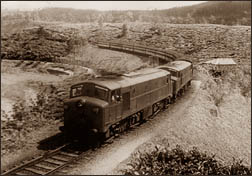
|
|||||
|
| |||||
Cutting the First Sod of Earth for the Railway in 1858
by Aryadasa RatnasingheA railway for Sri Lanka was first mooted in 1842. Since the British occupation of the island in 1815, the Europeans, looking for suitable investments were much attracted by the mild climate and rich soil found in the upland country. Most of the enterprising European planters opened up coffee plantations, having bought Crown Lands at 50 cents an acre. By 1872, the prosperity of the coffee industry had reached its zenith, but with the outbreak of the disease' blister blight' (Hemileia Vastatriz), coffee plantations were abandoned and replaced with tea. The tea plant was first introduced to the island in 1839. Since the planters were making rapid progress by clearing more and more waste lands, to produce the commercially viable crop tea, they soon felt the need for better transport to haul the bulk produce to Colombo for shipment, a distance of 115 km. from Kandy. The road transport facilities were not only costly but also time consuming. The planters now began to agitate for a railway to haul their produce to Colombo, as it was likely to be an important asset in the development of the plantation industry, and in the unification of the Kandy provinces with the maritime settlements. The Colonial Governor, Śrī Henry Ward (1855-1860), reacted to the idea favourably, and the Secretary to the State for the Colonies was informed about it. In 1845, the Ceylon Railway Company (CRC) was established in England, under the Chairmanship of Philip Anstruther, for the building of a railway in Sri Lanka, first up to Kandy, in fulfilment of the wishes of the planters. The Company's engineer Thomas Drane, made a preliminary survey in 1846, and he proposed three alternative routes to Kandy. They were Alagalla trace, the Hingula Valley trace and the Galagedera trace. The lowest estimate was Sterling Pounds 850,000. As a first step, the Government agreed to build a section of the route up to Ambepussa (a distance of 54 km. from Colombo), at a cost of Sterling Pounds 258,795. In 1856, provisional agreement was singed between the CRC and the Sri Lanka Government, to extend the line up to Kandy. The high expenditure alarmed the planters, who agitated for a fresh survey at reduced cost. The surveyor, Capt. Moorsom was assigned with the difficult task of tracing a new route at reduced cost. Capt. Moorsom came to Sri Lanka in 1857, for the purpose, and he recommended the present trace from Rambukkana to Kadugannawa, (via Kadigamuwa, Beddewela, Ihala Kotte, Balana). Immediately, laying the track began under the supervision of the engineer M.T. Doyne, who worked out the working plan in sectional detail, from the heart of Colombo to the city of Kandy, ascending the Kadugannawa Pass (the only broad-gauge track in the world to make the ascend within short distance, where the wheels of the locomotives bite into the rails to gather momentum). From Kelaniya to Gampaha (old Henarathgoda), the land was low and marshy, and had to be raised before laying the line with heavy cost. The CRC was keen to push the line through, but it was found that Capt. Moorsom's estimate was far below the expenditure needed. According to Doyne, 'Heavy and expensive work, such as cutting through solid rock and masses of boulders at the bases of hills and steep embankments over valleys and ravines appeared inevitable'. He was faced with practical problems and needed more money to lay the track. Finally, the contract with the CRC was terminated and the capital subscribed paid off. The Government took over the assets and liabilities of the CRC and the work was handled by the Ceylon Government Railway (CGR). As the Railway was considered an urgent need, fresh tenders were called to go ahead with the project. The lowest tender was from W.F. Faviell and G.L. Molesworth was appointed Resident Engineer. Later, he became the Director-General of Railways (1865-1871), to be succeeded by J.R. Mosse, Director of Public Works and Director-General of Railways (1871-1882). The first Lankan to become the General Manager, Railways, was M. Kanagasabay (1948-1955). Then came B.D. Rampala, who was unique among others as a capable officer and a locomotive engineer. It is interesting to note that Robert Stephenson (1803-1859), the son of George Stephenson (1781-1848), the loco engineer, who invented the steam engine Rocket, came to Sri Lanka as a civil engineer to supervise the construction of railway bridges. He had the reputation of building the railway line in Simla, a hill station in North India. The building of the Kelani bridge near Colombo was a work of magnitude. Originally, this substantial structure of 800 feet in length, was composed of 8 spans of 62 1/2 ft. built on screw piles, and 12 spans of 25ft. on brick piers. Following a heavy monsoonal rain, this bridge collapsed with the engine and crew on September 20, 1872. The present bridge is a later construction, with a double track, for heavier loading. In 1866, Mahara (now Ragama) and Gampaha stations were completed. The permanent way was pushed to Ambepussa on roughly finished track to run the first train to convey HRH the Duke of Brabant (later king Leopold II of Belgium) to Ambepussa and back on December 27, 1864. The line was opened up to Polgahawela for both passenger and goods traffic on November 1, 1866. The first tunnel on the Main Line is at Mirigama, and is 274 ft. long. Thereafter, up to Kandy, there are 9 tunnels, the longest being 1,095 ft. Tunnelling is a masterpiece of railway engineering, and their construction with antediluvian tools and equipment strikes wonder. The railway line was pushed to the top of the incline in December 1866, and the first material train steeped up the incline, puffing and coughing, and reached Kadugannawa on March 20, 1867. The bridge over the Mahaweli ganga and the girder bridge over the Maha Oya, were soon completed, and the final section to link Kandy was laid on April 25, 1867. The first train to Kandy from Colombo, ran on April 26, 1867. In 1865, extention to Gampola was authorised and opened for traffic in 1873. The section from Gampola to Nawalapitiya had immence engineering problems and it was completed in 1884. The trace to Nanu Oya from Nawalapitiya was completed in three stages, i.e., from Nawalapitiya to Hatton in 1884, then to Talawakelle in the same year and to Nanu Oya in 1885, and then to Bandarawela in 1894. Bandarawela was the terminus on the Main Line until the extention to Badulla was completed in 1924. It had taken 30 years to construct this part of the railway line, primarily due to the great depression economywise, caused by the World War I (1914-1918). Secondly, due to the topography of the land which was overcome by the Demodara Loop. Here the line loops itself after circumscribing an adjoining hill-top, and passes through a tunnel under the Demodara station, to emerge far below on a bridge flung across the rocky bed of the Gawara-ela. On this part of the track at Pattipola (6,226 ft. above sea level) the trains from Colombo descend to Badulla, which have hitherto been ascending the steepy mountains. Here the dawn of light and civilisation have crossed the dividing range of hills at Pattipola, and the smoke of the steam locomotives was seen all over the bleak and barren plains of the once desolate Uva. The firm Graig and Cockshot, under Oliver Smith, the engineer, worked on the Bandarawela extension, having removed the deadlock at Demodara. The first locomotive was imported in 1864 (a 4-4-0 type, two-wheeled coupled engine with a tender). All locomotives prior to dieselisation were steam engines, and some of them were super-heater boilers used on the Main Line. Then there were the Big Bank Engines. Until 1874, several locomotives built by Kitson & Co., John Flowler & Co, Bayer Peacock & Co., ploughed the track. The Garrat Class locomotives (double-engined in front and rear) was introduced in 1928, to eliminate the need for two engines to haul trains up-country, where the gradient, sometimes, is 1:40 (i.e., one foot high to every 40 feet in length). In 1933, three diesel locomotives were experimented and were withdrawn from service as unsuitable. In 1936, three articulated diesel electric train sets were purchased from English Electric Co., and they were named Silver Foam, Silver Mist and Silver Spray. They operated on the Coast Line. In 1954, Heavy Class General Motors diesel electric locomotives of 1,310 horse power, were gifted to Sri Lanka under the Colombo Plan. These engines were withdrawn from operating on the Main Line due to severe vibration endangering rock falls.
There are 46 tunnels on the Main Line, between Mirigama and Badulla and the longest among them is the Poolbank Tunnel, between Hatton and Kotagala, having a length of 562m. (1,842 ft.), with a curvature in the middle, so that one end of the tunnel cannot be seen from the other end. Tunnels and over-hanging rocks on the incline stand as a lasting monument to the genius of the Chief Engineer, Molesworth and to the skill of the contractor Faviell. On this section of the railway, one can see warning boards to drivers, reading 'Beware of Rock Falls'. At some places, trains run along the very edge of cliffs, with an almost sheer fall of several hundred feet into the abyss below. Sometimes, when a train enters the tunnel near Idalgashinna, there is sunshine, but when it emerges from the other end, there are clouds laden with mist. The Idalgashinna Railway station is by the very precipice overlooking the distant landscape below. A Railway for Sri Lanka was first mooted in 1842, though the first sod of earth for laying the line was cut by the governor Sir Henry Ward on August 3, 1858, amidst great jubilation of the jeering crowd, i.e., exactly 146 years ago. It was one time the best passenger transport system in the island, with facilities to travel comfortably, specially in long distant trains. The 1st Class was a luxury and the 2nd Class was the choice of public servants and businessmen. The compartments were well maintained unlike today, which are no better than the cattle wagons. Today, the Railway has proved to be a white elephant, full of corruption and lethargy, and running at a loss. On the other hand, derailments, accidents etc., have contributed for heavy losses, including damage to life and property. In the year 2003, there were 255 derailments and 585 engine failures. In the previous year, there were 104 derailments and 620 engine failures, mostly due to excessive speeding and negligence, on the part of the drivers. Even though damage was done to the rolling stock, the drivers continue to be at work, and sometimes, they are even being promoted as usual.
|


